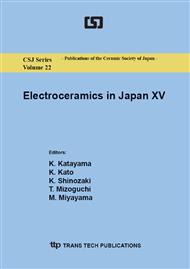p.223
p.227
p.231
p.237
p.241
p.245
p.249
p.253
p.258
Microstructure Control of Potassium Niobate Porous Ceramics and their Sensor Properties
Abstract:
Porous potassium niobate (KNbO3, KN) system ceramics were prepared by spark plasma sintering (SPS) method using carbon black (CB, 5 μm). First, the powders of raw materials were mixed in ethanol by ball milling, and then calcined. Obtained KN powders with CB were sintered by SPS in argon atmosphere. Their piezoelectric properties were measured and a relationship between porosity, pore size, and sensor properties was studied. It was found that d33 increased as pore size decreased. Thus, pore size was important for the improvement of value of g33/ρ.
Info:
Periodical:
Pages:
241-244
Citation:
Online since:
July 2013
Price:
Сopyright:
© 2013 Trans Tech Publications Ltd. All Rights Reserved
Share:
Citation:


